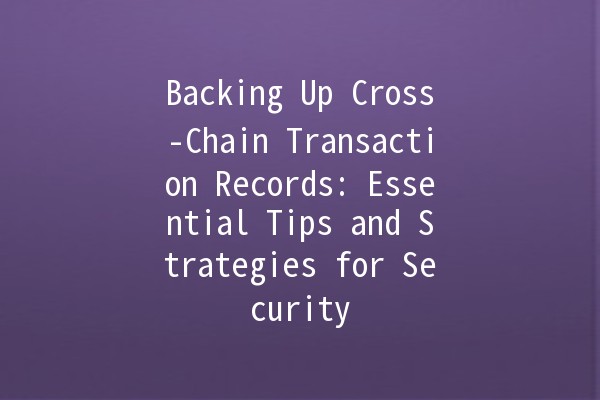
In the evolving landscape of blockchain technology, crosschain transactions are becoming increasingly common. These transactions allow the exchange of data and assets across different blockchain networks, which significantly enhances interoperability and user experience within the crypto ecosystem. However, with great innovation comes the need for robust security measures, particularly when it comes to safeguarding transaction records. This article delves into effective methods for backing up crosschain transaction records while ensuring the utmost security and accessibility.
Understanding CrossChain Transactions
Crosschain transactions enable users to transfer tokens or data from one blockchain to another. This functionality opens up exciting opportunities, such as utilizing decentralized applications (dApps) built on different networks or accessing liquidity from various sources. However, as the complexity of these transactions increases, so does the need for comprehensive recordkeeping and backup solutions.
The Importance of Backing Up CrossChain Transaction Records

Five Effective Techniques for Backing Up CrossChain Transaction Records
Decentralized storage platforms, such as IPFS (InterPlanetary File System) or Filecoin, offer a robust solution for backing up transaction records. These platforms distribute data across a network of nodes, ensuring high availability and redundancy.
Application Example: Store hashed versions of transaction records on IPFS, while keeping a reference in your primary blockchain ledger. This way, if your primary data source is compromised or lost, the transaction information is still retrievable.
Automation can significantly streamline the backup process. By utilizing scripts that automatically back up transaction records at regular intervals, you can minimize the risk of human error.
Application Example: Use a cron job to run a backup script nightly. This script could pull transaction data from your smart contracts and save it to a secure server or decentralized storage solution.
Multisignature wallets require multiple private keys to authorize a transaction, which can serve as an additional layer of security for backup practices. If some keys are lost, the data can still be recovered with the remaining keys.
Application Example: Store backup keys in secure physical locations or with trusted third parties. This not only protects against unauthorized access but also safeguards against loss of access due to personal circumstances.
Exporting detailed transaction reports periodically can provide snapshots of records that can be stored offline. This ensures that there is always a tangible backup of important information.
Application Example: Create a monthly report of all crosschain transactions that captures all relevant data points (e.g., sender, receiver, amount). Save these reports in encrypted files and store them in a secure physical location.
Creating a backup policy that outlines the procedures, frequency, and storage solutions for transaction records can significantly enhance your backup efforts. This policy should also include details on recovery procedures and roles assigned to staff members.
Application Example: Document your backup procedures in a company handbook, and hold quarterly training sessions to ensure all team members understand the process. This ensures consistent execution and allows for adjustments as needed.
Common Questions About Backing Up CrossChain Transaction Records
Crosschain transactions often involve multiple blockchains, increasing the complexity of the data structure. Each network has its own standards and security protocols, which can lead to inconsistencies and potential points of failure if not managed properly.
It is important to back up not just the transaction data itself (like token amount and addresses) but also metadata such as timestamps, transaction hashes, and any relevant contract information. This comprehensive approach ensures that reconstructions of any lost records can be done with minimal information.
In the event of compromised records, assess the extent of the breach. If backups were maintained following best practices, use them to restore lost data. Always review security protocols and adjust as necessary to prevent future incidents.
Backup frequency will depend on your transaction volume. For lowvolume operations, weekly backups might suffice; for highfrequency transactions, daily or even hourly backups may be necessary to mitigate risks.
While onchain data offers robustness due to its immutable nature, relying solely on it may not account for all aspects of transaction data. Offchain backups can provide crucial additional layers of security and redundancy.
There are numerous crypto tools available, such as blockchain explorers that offer export options, scripts for automation, and decentralized storage solutions. Evaluate different tools based on your specific needs and transaction volume to determine which will be most effective for your backups.
By implementing these strategies and understanding the importance of safeguarding crosschain transaction records, you can enhance data security and ensure compliance with necessary regulations. The adoption of decentralized storage and the establishment of a strong backup policy can provide peace of mind in the complex world of blockchains, allowing you to focus on leveraging crosschain transactions for your projects.

